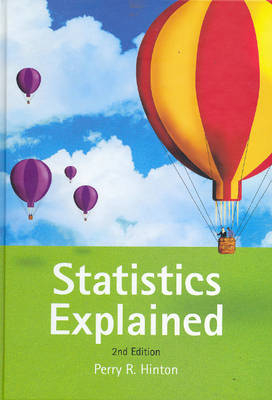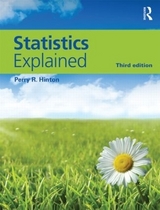
Statistics Explained
Routledge (Verlag)
978-0-415-33284-2 (ISBN)
- Titel erscheint in neuer Auflage
- Artikel merken
Statistics Explained clearly outlines the major statistical tests used by undergraduates in the social sciences. It provides easy-to-understand explanations of how and why they are used and makes statistics much less mysterious. This book:
Is a simple introduction to the jargon
Shows you when to be sceptical about statistics
Guides you in using computers in statistical analysis.
Statistics Explained can be dipped into so that readers can see why a specific analytical procedure was developed and what it is best used for. Readers can also analyse their own data by following the worked examples provided. People who understand statistics are not unusual. Anyone can do it. In this book, Perry Hinton shows that statistics can be a logical and helpful tool to all of us in deciding answers to our research questions. Statistics Explained will be warmly welcomed by students at all levels, and by the lecturers who struggle to teach them.
Perry R. Hinton, Oxford Brookes University, UK
Introduction. Descriptive Statistics. Measures of 'Central Tendency'. Measures of 'Spread'. Describing a Set of Data: In Conclusion. Comparing Two Sets of Data with Descriptive Statistics. Some Important Information About Numbers. Standard Scores. Comparing Scores from Different Distributions. The Normal Distribution. The Standard Normal Distribution. Introduction to Hypothesis Testing. Testing a Hypothesis. The Logic of Hypothesis Testing. One- and Two-tailed Predictions. Sampling. Populations and Samples. Selecting a Sample. Sample Statistics and Population Parameters. Summary. Hypothesis Testing with a Sample. An Example. When We Do Not Have the Known Population Standard Deviation. Hypothesis Testing with a Sample: In Conclusion. Selecting Samples for Comparison. Designing Experiments to Compare Samples. The Interpretation of Sample Differences. Hypothesis Testing with Two Samples. The Assumptions of the Two Sample t-test. Related Samples or Independent Samples. The Related t-test. The Independent t-test. Significance, Error and Power. Type I and Type II Errors. The Power of a Test. Increasing the Power of a Test. Conclusion. Introduction to the Analysis of Variance. Factors and Conditions. The Problem of Many Conditions and the t-test. Why Do Scores Vary in an Experiment? The Process of Analysing Variability. The F Distribution. Conclusion. One Factor Independent Measures ANOVA. Analysing Variability in the Independent Measures ANOVA. Rejecting the Null Hypothesis. Unequal Sample Sizes. The Relationship of F to t. Multiple Comparisons. The Turkey Test (for all Pairwise Comparisons). The Scheffé Test (for Complex Comparisons). One Factor Repeated Measures ANOVA. Deriving the F Value. Multiple Comparisons. The Interaction of Factors in the Analysis of Variance. Interactions. Dividing Up the Between Conditions Sums of Squares. Simple Main Effects. Conclusion. Calculating the Two Factor ANOVA. The Two Factor Independent Measures ANOVA. The Two Factor Mixed Design ANOVA. The Two Factor Repeated Measures ANOVA. A Non-significant Interaction. An Introduction to Nonparametric Analysis. Calculating Ranks. Two Sample Nonparametric Analysis. The Mann^DDLWhitney U Test (for Independent Samples). The Wilcoxon Signed-ranks Test (for Related Samples). One Factor ANOVA for Ranked Data. Kruskal^DDLWallis Test (for Independent Samples). The Friedman Test (for Related Samples). Analysing Frequency Data: Chi-square. Nominal Data, Categories and Frequency Counts. Introduction to Chi-square. Chi-square as a 'Goodness of Fit' Test. Chi-square as a Test of Independence. The Chi-square Distribution. The Assumptions of the Chi-square Test. Linear Correlation and Regression. Introduction. Pearson r Correlation Coefficient. Linear Regression. The Interpretation of Correlation and Regression. Problems with Correlation and Regression. The Standard Error of the Estimate. The Spearman r/s Correlation Coefficient. Multiple Correlation and Regression. Introduction to Multivariate Analysis. Partial Correlation. Multiple Correlation. Multiple Regression. Using Statistics Programs on Computers. Errors in Data Input. Interpreting Output. Conclusion. Notes. Glossary. Appendix.
| Erscheint lt. Verlag | 15.7.2004 |
|---|---|
| Verlagsort | London |
| Sprache | englisch |
| Maße | 174 x 246 mm |
| Gewicht | 930 g |
| Themenwelt | Geisteswissenschaften ► Psychologie ► Test in der Psychologie |
| Mathematik / Informatik ► Mathematik ► Statistik | |
| ISBN-10 | 0-415-33284-2 / 0415332842 |
| ISBN-13 | 978-0-415-33284-2 / 9780415332842 |
| Zustand | Neuware |
| Informationen gemäß Produktsicherheitsverordnung (GPSR) | |
| Haben Sie eine Frage zum Produkt? |
aus dem Bereich



